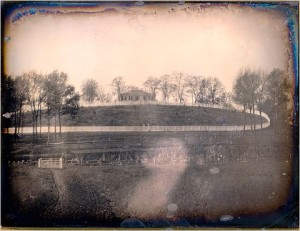Old Photos

I remember picking through a box of my grandmother and grandfather’s photos in my attic when I was a kid. I’d see photos the only vaguely recognizable forms of my grandparents on various idyllic scenes in what appeared to be some distant foreign countryside. Except this wasn’t the case- when you’d turn them over, you’d see in nearly written pencil script the date and in a few lucky instances an intersection or landmark.
This is what’s so compelling about the recent sale of a rare early New York City daguerreotype. This idyllic scene could have been anywhere in the country; however, researchers had a clue to go off in the form of some neat handwriting on the back:Â
This view, was taken at too great a distance, & from ground 60 or 70 feet lower than the building; rendering the lower Story of the House, & the front Portico entirely invisible. (the handsomest part of the House.) The main road, passes between the two Post & rail fences. (called, a continuation of Broadway 60 feet wide.) It requires a maganifying glass, to clearly distinguish the Evergreens, within the circular enclosure, taken the last of October, when nearly half of the leaves were off the trees. -May 1849. L. B.
Researchers used the words “continuation of Broadway” to uncover that this house was likely located on a road on the Upper West Side of Manhattan.Â
My grandchildren are unlikely to have a shoe box of photos to dig through. My honeymoon won’t be captured on sepia-toned sheets of Kodak photo paper, carefully annotated for posterity. They may- if they’re lucky and the file formats we use today are still readable by future technology – have only a bunch of files with cryptic names like DSC_0521.jpg or 07-75_20047.jpg, without notes. Has the art of labeling photographs died with the Polaroid, or will future image technologies re emphasize the art of tagging using the largely dormant use of meta-tags in our photos? This dageuerreotype serves as a reminder that we should not forget to contextualize our own histories, lest the whole point of documenting be lost!
Last 5 posts by ASHP Staff
- FDR's Tree Army [now on Vimeo] - March 13th, 2013
- December Roundup - December 19th, 2012


